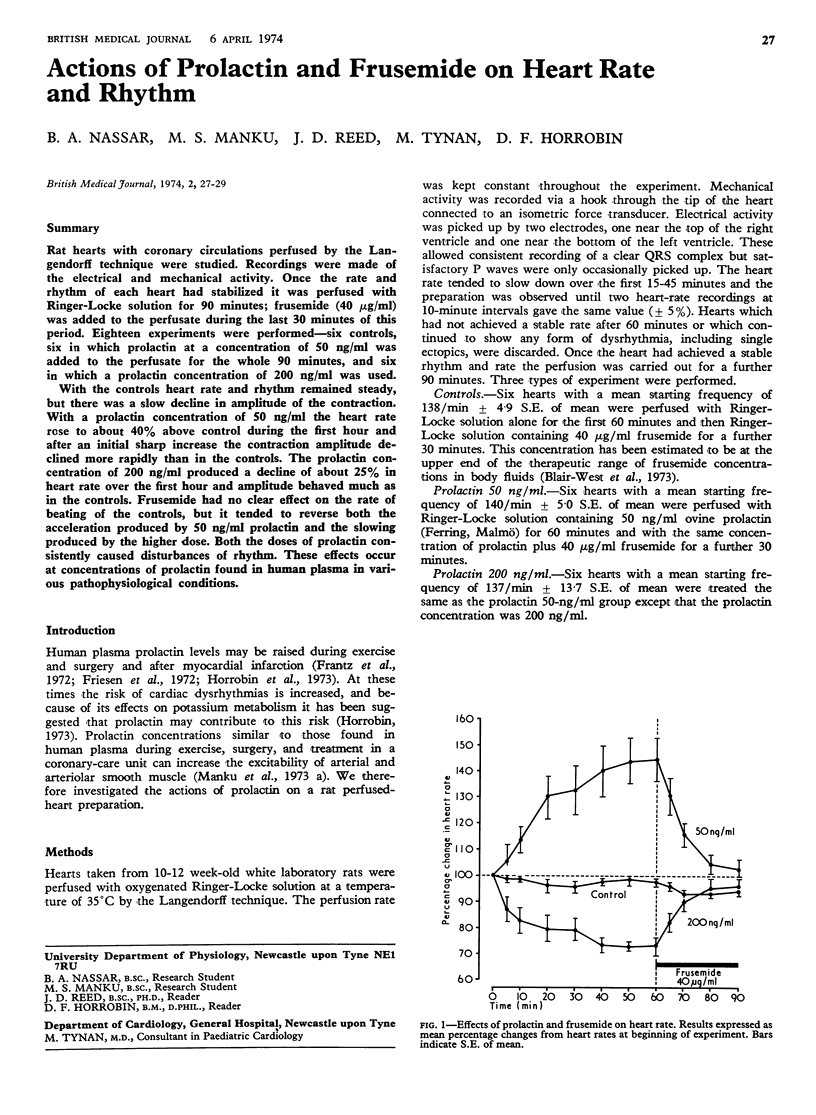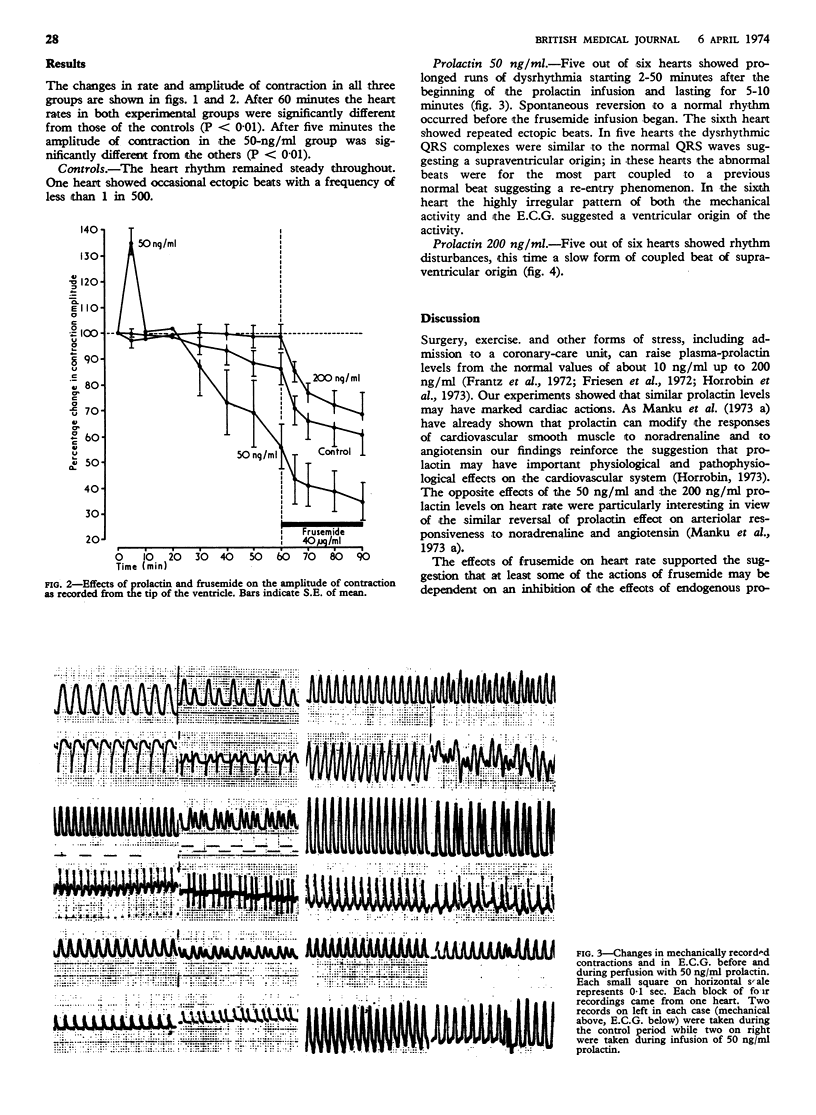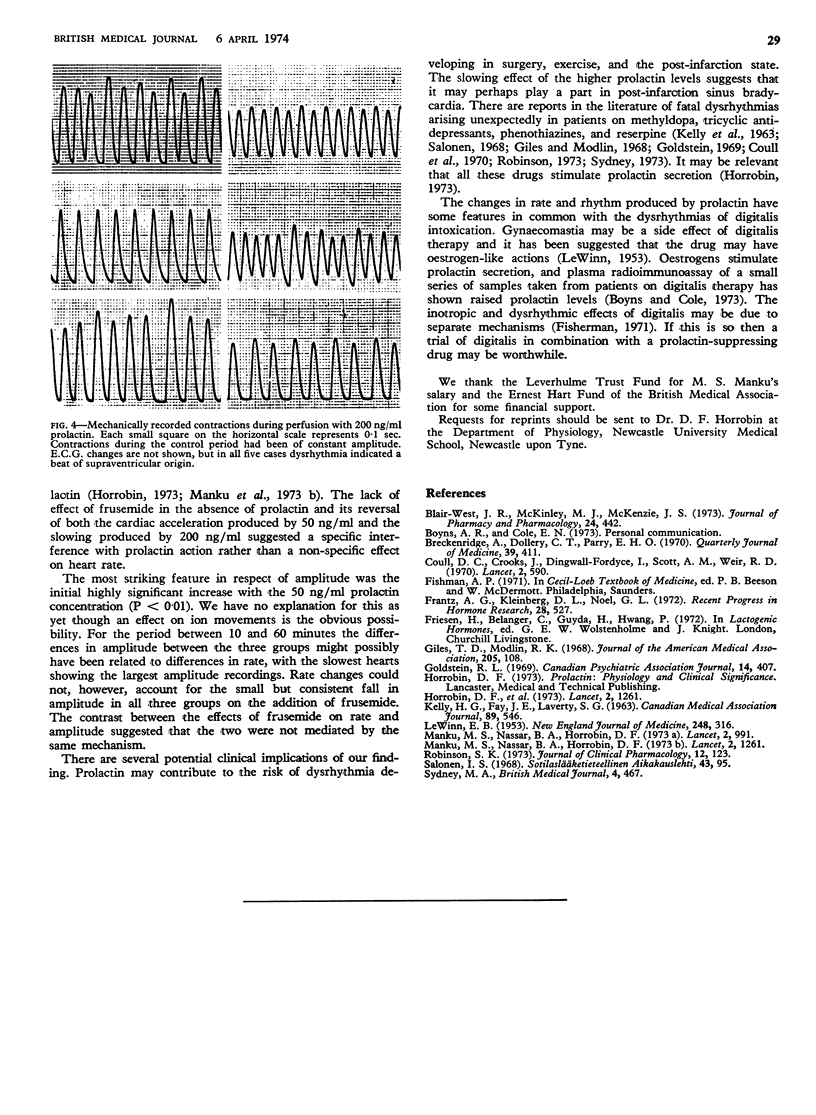Abstract
Rat hearts with coronary circulations perfused by the Langendorff technique were studied. Recordings were made of the electrical and mechanical activity. Once the rate and rhythm of each heart and stabilized it was perfused with Ringer-Locke solution for 90 minutes; frusemide (40 μg/ml) was added to the perfusate during the last 30 minutes of this period. Eighteen experiments were performed—six controls, six in which prolactin at a concentration of 50 ng/ml was added to the perfusate for the whole 90 minutes, and six in which a prolactin concentration of 200 ng/ml was used.
With the controls heart rate and rhythm remained steady, but there was a slow decline in amplitude of the contraction. With a prolactin concentration of 50 ng/ml the heart rate rose to about 40% above control during the first hour and after an initial sharp increase the contraction amplitude declined more rapidly than in the controls. The prolactin concentration of 200 ng/ml produced a decline of about 25% in heart rate over the first hour and amplitude behaved much as in the controls. Frusemide had no clear effect on the rate of beating of the controls, but it tended to reverse both the acceleration produced by 50 ng/ml prolactin and the slowing produced by the higher dose. Both the doses of prolactin consistently caused disturbances of rhythm. These effects occur at concentration of prolactin found in human plasma in various pathophysiological conditions.
Full text
PDF


Selected References
These references are in PubMed. This may not be the complete list of references from this article.
- Blair-West J. R., McKinley M. J., McKenzie J. S. Effect of frusemide on the reactivity of rat portal vein. J Pharm Pharmacol. 1972 Jun;24(6):442–446. doi: 10.1111/j.2042-7158.1972.tb09029.x. [DOI] [PubMed] [Google Scholar]
- Breckenridge A., Dollery C. T., Parry E. H. Prognosis of treated hypertension. Changes in life expectancy and causes of death between 1952 and 1967. Q J Med. 1970 Jul;39(155):411–429. [PubMed] [Google Scholar]
- Coull D. C., Crooks J., Dingwall-Fordyce I., Scott A. M., Wier R. D. Amitriptyline and cardiac disease. Risk of sudden death identified by monitoring system. Lancet. 1970 Sep 19;2(7673):590–591. doi: 10.1016/s0140-6736(70)90169-8. [DOI] [PubMed] [Google Scholar]
- Frantz A. G., Kleinberg D. L., Noel G. L. Studies on prolactin in man. Recent Prog Horm Res. 1972;28:527–590. [PubMed] [Google Scholar]
- Giles T. D., Modlin R. K. Death associated with ventricular arrhythmia and thioridazine hydrochloride. JAMA. 1968 Jul 8;205(2):108–110. [PubMed] [Google Scholar]
- Horrobin D. F., McNeilly A. S., Jackson F. S., Reid D. S., Tynan M., Nassar B. A., Manku M. S., Elliott K. Letter: Prolactin and myocardial infarction. Lancet. 1973 Dec 1;2(7840):1261–1261. doi: 10.1016/s0140-6736(73)90997-5. [DOI] [PubMed] [Google Scholar]
- KELLY H. G., FAY J. E., LAVERTY S. G. THIORIDAZINE HYDROCHLORIDE (MELLARIL): ITS EFFECT ON THE ELECTROCARDIOGRAM AND A REPORT OF TWO FATALITIES WITH ELECTROCARDIOGRAPHIC ABNORMALITIES. Can Med Assoc J. 1963 Sep 14;89:546–554. [PMC free article] [PubMed] [Google Scholar]
- LEWINN E. B. Gynecomastia during digitalis therapy; report of eight additional cases with liver-function studies. N Engl J Med. 1953 Feb 19;248(8):316–320. doi: 10.1056/NEJM195302192480802. [DOI] [PubMed] [Google Scholar]
- Manku M. S., Nassar B. A., Horrobin D. F. Effects of prolactin on the responses of rat aortic and arteriolar smooth-muscle preparations to noradrenaline and angiotensin. Lancet. 1973 Nov 3;302(7836):991–994. doi: 10.1016/s0140-6736(73)91089-1. [DOI] [PubMed] [Google Scholar]
- Salonen I. S., Räsänen O. Reserpiinin aiheuttama sydäninfarkti. Sotilaslaak Aikak. 1968;43(3):95–97. [PubMed] [Google Scholar]


